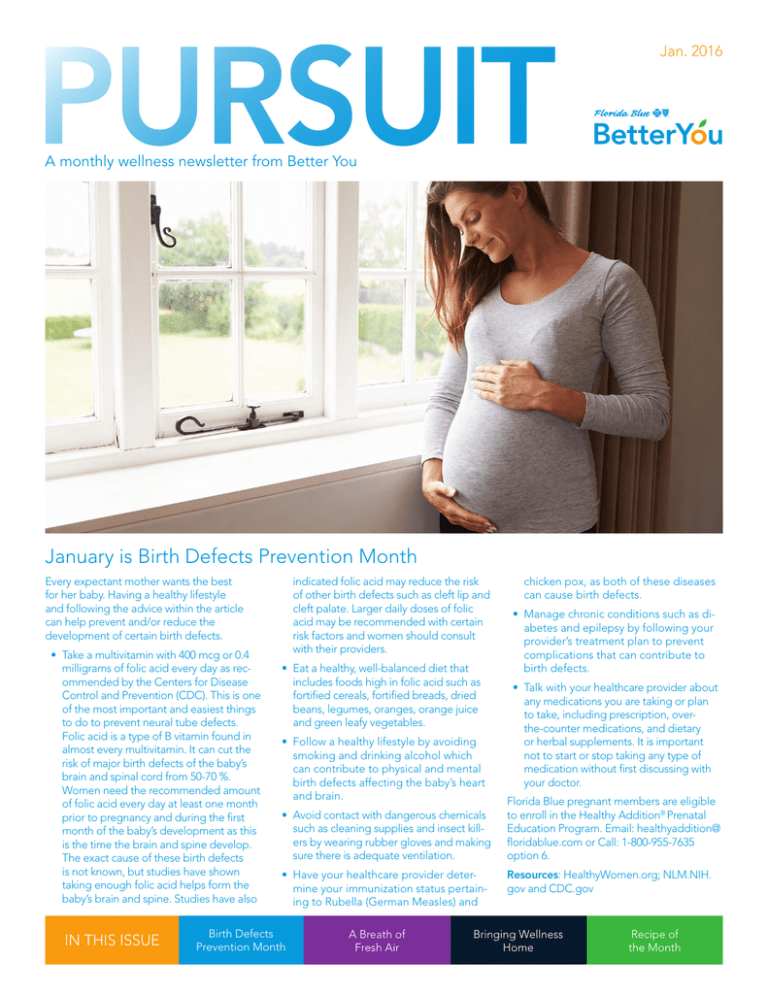PURSUIT January is Birth Defects Prevention Month Jan. 2016
advertisement

PURSUIT Jan. 2016 A monthly wellness newsletter from Better You January is Birth Defects Prevention Month indicated folic acid may reduce the risk of other birth defects such as cleft lip and cleft palate. Larger daily doses of folic acid may be recommended with certain risk factors and women should consult with their providers. Every expectant mother wants the best for her baby. Having a healthy lifestyle and following the advice within the article can help prevent and/or reduce the development of certain birth defects. • Take a multivitamin with 400 mcg or 0.4 milligrams of folic acid every day as recommended by the Centers for Disease Control and Prevention (CDC). This is one of the most important and easiest things to do to prevent neural tube defects. Folic acid is a type of B vitamin found in almost every multivitamin. It can cut the risk of major birth defects of the baby’s brain and spinal cord from 50-70 %. Women need the recommended amount of folic acid every day at least one month prior to pregnancy and during the first month of the baby’s development as this is the time the brain and spine develop. The exact cause of these birth defects is not known, but studies have shown taking enough folic acid helps form the baby’s brain and spine. Studies have also IN THIS ISSUE • Eat a healthy, well-balanced diet that includes foods high in folic acid such as fortified cereals, fortified breads, dried beans, legumes, oranges, orange juice and green leafy vegetables. • Follow a healthy lifestyle by avoiding smoking and drinking alcohol which can contribute to physical and mental birth defects affecting the baby’s heart and brain. • Avoid contact with dangerous chemicals such as cleaning supplies and insect killers by wearing rubber gloves and making sure there is adequate ventilation. • Have your healthcare provider determine your immunization status pertaining to Rubella (German Measles) and Birth Defects Prevention Month A Breath of Fresh Air chicken pox, as both of these diseases can cause birth defects. • Manage chronic conditions such as diabetes and epilepsy by following your provider’s treatment plan to prevent complications that can contribute to birth defects. • Talk with your healthcare provider about any medications you are taking or plan to take, including prescription, overthe-counter medications, and dietary or herbal supplements. It is important not to start or stop taking any type of medication without first discussing with your doctor. Florida Blue pregnant members are eligible to enroll in the Healthy Addition® Prenatal Education Program. Email: healthyaddition@ floridablue.com or Call: 1-800-955-7635 option 6. Resources: HealthyWomen.org; NLM.NIH. gov and CDC.gov Bringing Wellness Home Recipe of the Month New Year’s Resolution: A Breath of Fresh Air Nicotine is a highly addictive substance in tobacco. No wonder it is so hard for smokers to quit! About 80% to 90% of smokers are addicted to the nicotine in cigarettes. The purpose of this article is to share some of the challenges faced when quitting smoking, provide you with tools to successfully quit and start the New Year with a breath of fresh air! There are a few things to think about if you want to quit. The act of smoking cigarettes is associated with the oral fixation that a cigarette to your lips provides. To help overcome this behavior, try sipping water or chewing a piece of sugarless gum when you start to crave a cigarette. Keep your hands busy by playing with a pencil, paper clip or marbles, or snack on fruits and vegetables. If you smoke after meals, do something else instead like brushing your teeth. Most people light up in times of stressful situations, so be sure to find other ways to manage your stress. Go for a walk, listen to relaxing music or get a massage. Smoking is an expensive habit. Just think of all the money you would save if you quit! The average pack-a-day smoker in Florida spends more than $2,000 per year on cigarettes. Reward yourself by using that money you would have spent on cigarettes on something fun. Last but not least, tie your desire to become tobacco-free to a deep emotional cause (i.e. staying healthy, being a role model to your children, etc.). Choose a reason that is strong enough to outweigh the urge to light up. You may be tempted to quit cold turkey but that is not as easy as it seems. About 95% of people who quit without counseling and/ or nicotine replacement therapy end up relapsing. Smokers are most successful quitting when nicotine replacement therapy/medication is coupled with counseling. Make sure to tell your family and friends you are trying to quit so they can provide encouragement and support. Here are some free resources to get you started. You can do it! • Talk to a Quit Coach® who can help you quit tobacco by dialing 1-877-822-6669. • An online program to help you quit tobacco is only a click away by visiting www.quitnow.net/florida. • Looking for local face-to-face help? Find classes near you by visiting www. AHECtobacco.com. • Sign up for free texts: Free 24/7 quit help texted to your phone! Text QUIT to 47848, answer a few questions, and the support begins. Resources: WebMD.com, CDC.gov Bringing Wellness Home: Making Better Beverage Choices Now that the holidays are over and all those special occasions and celebrations are behind us, it’s time to refocus and get back into a healthy routine. High calorie foods and drinks certainly seem to be a common theme during the holiday season, so where do you start? Making better drink choices is an excellent starting point. Drinking sweetened beverages such as sodas (not diet), sports drinks, juice drinks, energy drinks and sweetened teas can contribute to weight gain. The American Heart Association states, “About onethird of Americans are overweight or obese, including nearly 13 million children. Childhood obesity has become a major health concern, causing health problems in children that previously weren’t seen until adulthood such as high blood pressure, type 2 diabetes and high cholesterol. Parents are the key to helping overcome this national epidemic.” So what can you do to help you and your children make healthier drink choices? Here are some ways to make smart beverage choices: • Choose water, diet, or low-calorie beverages instead of sweetened beverages. • For a quick, easy, and inexpensive thirstquencher, carry a water bottle and refill it throughout the day. • Pack water in your children’s school lunches. • Don't stock the fridge with sweetened beverages. Instead, keep a jug or bottles of cold water in the fridge. • Serve water, fat-free or 1% low fat milk with meals. • Make water more exciting by adding slices of lemon, lime, cucumber, or fruit, or drink sparkling water. • Add a splash of 100% juice to plain sparkling water for a refreshing, low-calorie drink. • Serve vegetable juice. • When you do opt for a sweetened beverage, go for the small size. Some companies are now selling 8 oz. cans and bottles of soda, which contain about 100 calories. • Be a role model for your friends and family by choosing healthy, low-calorie beverages. Let’s face it, there still are times when a sweetened drink is just what you or your child wants and that’s okay. Focus on limiting those times to occasional special events. What you drink makes more of a difference in your daily calories than you think. Being aware, reading food labels and coming up with creative ideas for drink alternatives will benefit the entire family! For more information visit the American Heart Association and the Center for Disease Control and Prevention websites. Resources: http://www.heart.org/ HEARTORG, click on the Getting Healthy Tab, select Healthier Kids option, then select How to Make a Healthier Home; and www.CDC.gov JAN 2016 2 Fresh and Healthy Recipe of the month Creamed Swiss Chard Available year-round, Swiss chard is among the most tender and sweet of the cooking greens. Like all dark leafy greens, it's high in nutrients. Here, soy milk contributes richness but virtually no fat. Ingredients: PHOTO: FINECOOKING.COM • 2 tablespoons olive oil • 1 1/2 tablespoons unbleached all-purpose flour • 3 garlic cloves, finely chopped • 1 1/4 cups low-fat plain soy milk • 2 pounds Swiss chard, washed, stemmed and cut crosswise into strips 1/2-inch wide • 1/4 teaspoon salt • 1/2 teaspoon freshly ground black pepper • 1 tablespoon grated parmesan cheese Preparation: 1. In a large frying pan, heat the olive oil over medium heat. Whisk in the flour to make a smooth paste. Continue whisking and add the garlic; cook for 30 seconds longer. Whisk in the soy milk and cook until the mixture thickens slightly. 2. Add the chard and stir to coat well. Cover and cook just until tender, about 2 minutes. Season with the salt and pepper. Sprinkle with parmesan and serve hot. Nutrition: Serves 6. One serving: Calories 101; Total carbohydrate 8 g; Dietary fiber 3 g; Sodium 297 mg; Total fat 5g; Saturated fat 1 g; Monounsaturated fat 3 g; Cholesterol 1 mg; Protein 5 g. Recipe courtesy of MayoClinic.com Florida Blue is a trade name of Blue Cross and Blue Shield of Florida, Inc., an Independent Licensee of the Blue Cross and Blue Shield Association. All materials, content and forms contained in this newsletter are the intellectual property of Better You and may not be copied, reproduced, distributed or displayed in full or in part without expressed written permission by Better You. 85757 0116 JAN 2016 3




